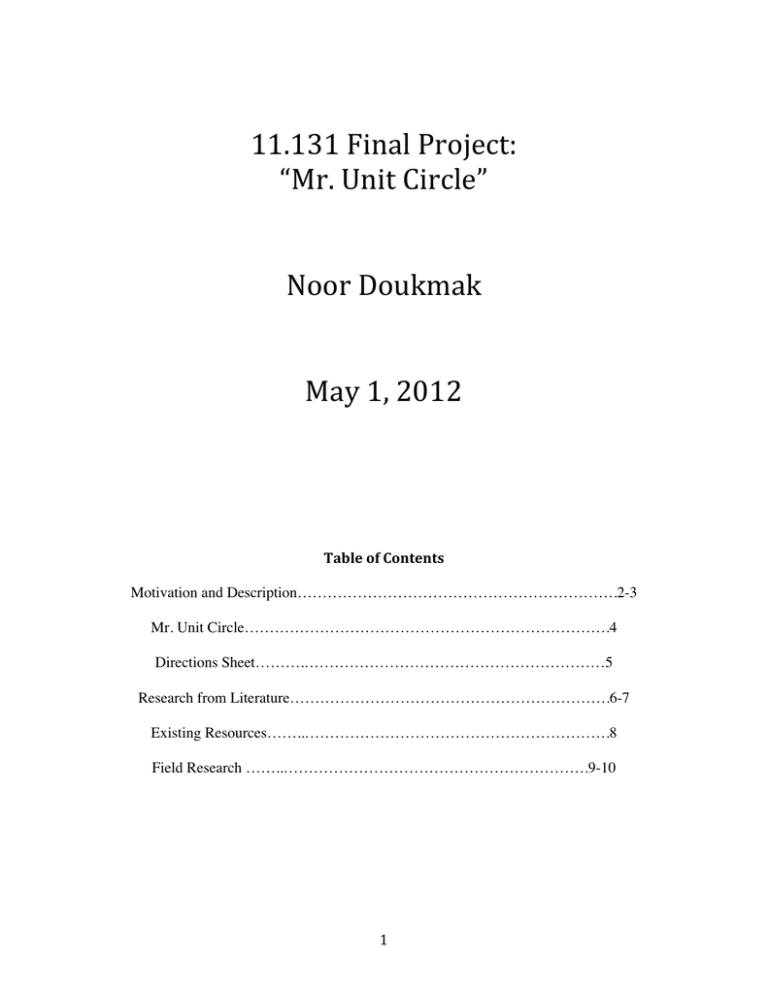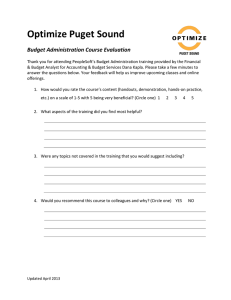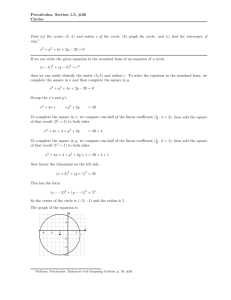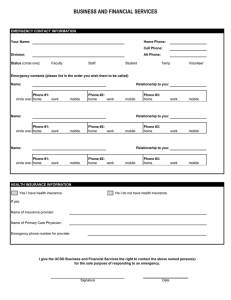Document 13640080
advertisement

11.131 Final Project: uMr. Unit Circle" Noor Doukmak May 1, 2012 Table of Contents Motivation and Description……………………………………………………….2-3 Mr. Unit Circle……………………………………………………………….4 Directions Sheet……….……………………………………………………5 Research from Literature……………………………………………………….6-7 Existing Resources……..…………………………………………………….8 Field Research ……..…………………………………………………….9-10 1 Mr. Unit Circle: Motivation and Description The precalculus class spends two to three months on trigonometric functions and the concept of overlaying the unit circle with marked angle measures onto the x-y coordinate plane. The beautiful connection that allows this concept to aid in the solving of numerous types of problems is the fact that uP," the point of intersection of the terminal side of an angle t with the unit circle has coordinates (cose, sine). They need to drop a perpendicular line to the x- and y-axes to find the trigonometric ratios of what I call uexotic" angles that are otherwise intimidating to find trigonometric ratios of. My precalculus students have mentioned to me their desire for hands-on learning during class. While I have managed to pull off a few hands-on activities over the course of my practicum, I did so with difficulty, sensing a lack of resources especially because there was no projector to attach a computer to in my classroom. Consequently, providing a hands-on learning experience was expensive in terms of my time. I had to get creative. With Mr. Unit Circle, however, I envision a class of precalculus students will come in and have an interactive hands-on piece to every lesson they attend that involves trigonometry and the unit circle because the apparatus integrates so well with the curriculum. Making learning hands-on should no longer be expensive on the teacher; on the contrary, it will only be natural to incorporate it into the lesson. My culminating project this year had two parts. First, I will describe the design and construction of the apparatus: it is in the shape of a circle with appropriate labels of terminal sides overlaid onto a coordinate plane. It has a hand like the hand of a clock at the center of the circle. This hand is free to rotate about the center and is long enough to be bent into the perpendicular line segment that is dropped to the x- or y- axis to form a right 2 triangle. It is meant to be created by the students at the beginning of the trigonometry unit and can be easily incorporated into lessons and even assessments, both formative and summative. Students can conveniently raise it up and show their teacher their work during a lesson. The second part of the culminating project is the accompanying instruction sheet with clear, easy-to-follow directions and diagrams so that students and teachers can make the apparatus themselves at the introduction of the trigonometry unit. This adds a personal touch to the apparatuses as students can customize them to their own liking. Since they will use them throughout several months, having hand-made their unit circles will make the students more likely to appreciate them. Please continue to the next section to see the basic structure of the unit circle apparatus as well as the directions handout. 3 Unit Circle Structure 0 0 0 L1) '<t 0 C') >< II <: 1-0 0 <0 Coordinate plane: jwilson.coe.uga.edu/EMAT6680/Simmons/Assignment%2010/image8.gif Unit Circle: www.flickr.com/photos/26661581@N07/2499249823/in/photostream 4 Mr. Unit Circle Directions Sheet Materials 1. Unit Circle Handout 2. 8"x11" piece of cardboard 3. Wire (or paperclip or pipe cleaner) 4. Glue (or tape) 5. Scissors Instructions 1. Glue (or tape) the unit circle handout to the piece of cardboard. 2. Unbend the wire until it is straight. 3. Using scissors if necessary, bend the end of the wire twice, until it looks like: 4. Insert the bent end into the center of the unit circle. 5. Now bend the wire again so it is as follows on the unit circle: 6. Now you are free to rotate the wire around to your heart's desire and adjust the bending accordingly. 7. Remember, 5 Research Component: Literature Mr. Unit Circle is a handheld tool about the size of a book that allows students to swing a hand around a pivot point in the middle of a circle overlaid onto a coordinate plane system. It is intended to help students visualize the multiple relationships that exist between angles on the unit circle and lengths on the coordinate plane. The main purpose for its creation and implementation is facilitating the existence of an interactive component to every trigonometry-related lesson, of which there are many in a typical precalculus course. Viewing its effects on student learning from an educational theorist's lens, having a hands-on tool that is in use for a long duration of the lesson is an excellent thing. A look at Figure 6.1 in The Skilllul Teacher shows a beautifully illustrated way of thinking about time allocation in a school setting. The diagram reads, from outside to inside, utime in school, allocated time, teacher instructional time, student engaged time, academic learning time, interactive instructional time" (Saphier 51) to describe the classification of how a student spends his/her time on a given day. When Mr. Unit Circle is used appropriately, what would otherwise be simply uteacher instructional time" immediately transforms into uinteractive instructional time." This is because instruction will become inherently interactive in nature. As stated in the book, uwhen it comes to this category, research findings have indicated the more, the better" (Saphier 56). What does it mean for a teacher to use this tool appropriately? It means the teacher should incorporate her Mr. Unit Circle (preferably an enlarged, more visible version) in her explanation of topics and immediately ask the students to reciprocate and display their own Unit Circles to her. This would require nothing more than the lifting of an arm from 6 each student, and suddenly the teacher is able to gauge student understanding in a formative way. As discussed in Chapter 19 of The Skilllul Teacher, this type of assessment can be used uto continually gather data about how well students are understanding during instruction" (Saphier 431). Chapter 7 of the same book discusses routines in the classroom, and Mr. Unit Circle should be an effective way to weave these two concepts together. Routines uare valuable ways of organizing and managing a class," yet another important function of this tool (Saphier 69). Discussion of the field research in terms of implementation and comments from precalculus students as well as feedback and comments from precalculus teachers can be found in the last section of this document. Resources Saphier, Jon, and Robert R. Gower. The Skilllul Teacher: Building Your Teaching Skills. Acton, MA: Research for Better Teaching, 1997. Print. 7 Existing Resources The activity on unit circles on Khan Academy (http://www.khanacademy.org/exercise/unit circle) is almost a digital version of what I envision Mr. Unit Circle to be. The specifics of what students will be able to do are a little different, but the gist is the same. Therefore, I think that the Khan Academy activity should be introduced immediately before the students begin building unit circles of their own. Because my mentor teacher's classroom is not equipped with a computer projector, this could be left as a homework assignment. The need for having the tangible unit circles, then, is even more evident. They are a way for precalculus classes to overcome the challenges of not having a computer projector accessible during class. With the accompaniment of having seen the computer animation before, interacting with and using the unit circle should provoke memories of the notions the Khan Academy activity beautifully illustrates. In terms of graphics, I used images from the following two locations and then edited Coordinate plane: jwilson.coe.uga.edu/EMAT6680/Simmons/Assignment%2010/image8.gif Unit Circle: www.flickr.com/photos/26661581@N07/2499249823/in/photostream them and combined them on my own to form the unit circle shown above. 8 Field Research The most important research I did was actually observing precalculus students making and interacting with the apparatuses. I visited the class I taught during my practicum and handed out the materials and the instruction sheet to the students. I told them I would not explain and that instead I wanted them to try to construct the unit circles on their own. They could raise their hands if they had questions, of course. The students certainly gave valuable feedback. For example, at the time, my idea was to use paperclips as the wires necessary for the making of the hand. Most questions were about how to bend the paper clip well enough or in the right enough shape to make it work. After dealing with several unit circles and breaking paperclips, I realized that more flexible wire or pipe cleaners were definitely preferable. This change is reflected in the current directions handout above. Some clarification was needed for one of my students about the wording of step 4 in the instructions, so I changed the handout to reflect that as well. Mrs. S and Mr. D are two precalculus teachers whom I interviewed about my apparatus. They both provided valuable input. Namely, Mrs. S recommended that the unit circle not have all twelve of the usual angles labeled; instead, it would be a better cognitive exercise every time a student used the unit circle if he/she had to make connections and figure out for him/herself what the angles larger than '/2 were. She also recommended having the degree-equivalent measures available so students could quantify those visually. After showing my idea to Mr. D, he asked me if he could use it for his precalculus classes. I was thrilled! I of course gave him copies of the handouts as well as some of the materials needed and asked him what he thought made it a successful tool. He said that with it, uYou can see coterminal angles really easily" and went on to say that this was 9 something his students struggled with. He mentioned that especially if students hold a straight edge up to the diagram, uit will be very easy for them to see that the first and second quadrant have the same sine [and] the second and third quadrant have the same cosine," for example. He also said, uI think it will be very useful.they could see the notions of smaller things like why the inverse of sine goes from - '/2 to '/2" and the notions of continuity. Mr. D summed up beautifully what this apparatus does. He said, uIt renders all those things more clear because kids can manipulate it and interact with it and that's always a big advantage." He continued, uIf you can pull on it and see it change, then you can start inferring how your action causes that change whereas that understand has to be built into any purely intellectual model, and if it's not, then their model is usually wrong and there is some sort of misconception." Finally, it is important to assess the impact on student learning. After the student in my precalculus class constructed the apparatus, I demonstrated how it can be used to find the cosine of '/3 and then asked them to find the sine of '/6. The result was reactions like, uI never thought of it like that!" I was pleased to have shown my students a new way of thinking about angles, and I look forward to receiving feedback from Mrs. S and Mr. D next year when they implement it in their precalculus classrooms from the beginning of the trigonometry unit. 10 MIT OpenCourseWare http://ocw.mit.edu 11.131 Educational Theory and Practice III Spring 2012 For information about citing these materials or our Terms of Use, visit: http://ocw.mit.edu/terms.



